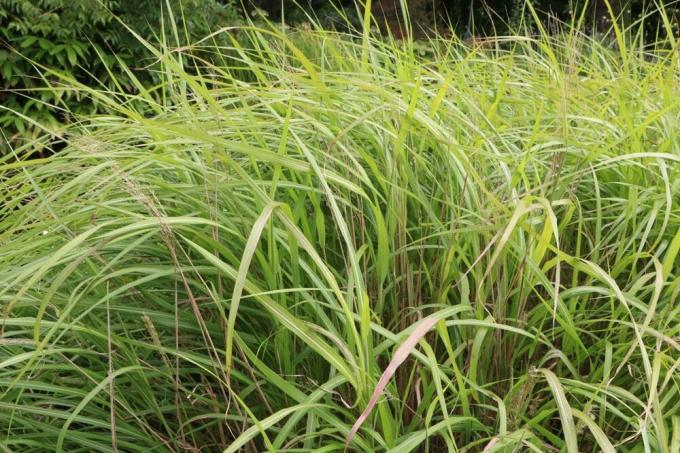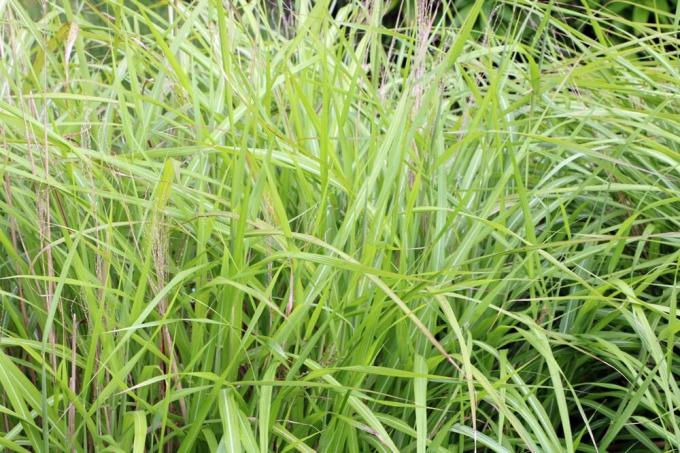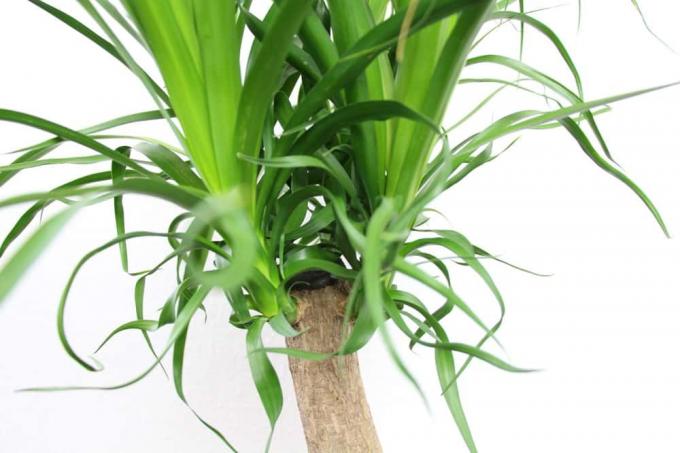

Table of contents
- Location
- time
- nature
- fleece
- plastic
- alternatives
- Size
- method
- work steps
- installation risks
- Conclusion
To prevent roots from spreading far, so-called root barriers are used. These ensure a local limitation of root growth. The Chinese reed from the plant genus Miscanthus is basically one of the less runner-forming plants. However, under certain circumstances they can spread widely and cause damage, especially at specific locations. You can find out how to prevent this with a rhizome and how you should proceed in the following instructions.
Location
Chinese reed is an extremely hardy plant that will grace gardens for many years. With increasing age and growth, the root system also grows. This digs its way through the earth a few meters long and/or wide. Depending on the constitution of the Chinese reed, these roots can appear concentrated and cause damage within a radius of four to five meters.
First of all Chinese reeds, in the vicinity of which there is a pond with foil, a well-groomed lawn, paved paths, electrical lines or water and sewage pipes should be provided with a rhizome as a precaution become. The vigor of growth and the amount of roots are capable of damaging insulation, metals and plastics and clogging pipes or pipes.
They can push up cobblestone paths and even ruin the foundations of buildings, resulting in costly repairs at worst. It is therefore essential that Chinese reed in particular is surrounded with a rhizome blockade when these in the immediate vicinity of the site with risk factors already mentioned or similar condition.
time
The root barrier for Chinese reed should ideally be set when planting. This saves labor, time and effort. In addition, it provides immediate protection and the roots can spread to a predetermined size from the start. Anyone who has already planted this type of reed can also add rhizome blockades later. However, this requires exposing or even digging up the plant so that the soil area can be optimally equipped with the root barrier. This is much more difficult and more expensive than immediately planting a barrier for roots.
Since planting out, replanting and planting a Chinese reed is only advisable in spring or late summer, this is also the period in which rhizome barriers should be used.
It is also advisable to choose a dry, sunny day for installing root barriers. Especially when working with glue, it dries better in these weather conditions. This minimizes the risk of adhesive weak points and subsequent ingress of dirt and/or soil.
nature
In order to achieve perfect functionality in the long term, the composition of the material must be taken into account when choosing a rhizome barrier. This is partly due to the robustness of the material, which has to withstand the pressure of the roots. The inner sides should be designed in such a way that the root ends cannot get stuck there, as this will increase the pressure on the material over time. In addition, it should be weatherproof, tolerate frost, not rust and consequently have a long service life.
fleece
A fleece material is ideal. Many professional gardeners are increasingly using fleece because it is easy to process, reliably prevents roots from spreading uncontrolled and is neither sensitive to frost nor rusts. The special, high-quality fleece has a very smooth structure on the inside so that the root ends cannot dock there. But above all, the water permeability of fleece is advantageous. This allows excess water to run off in all directions, which is not the case with some other materials and thus increases the risk of waterlogging.
However, the so-called root fleece or also called spunbonded fleece is usually only offered by the meter. This means the two ends must be joined, creating a weak point that may not be able to withstand the pressure of the roots over the long term. In addition, the special root barrier fleece is quite expensive to buy compared to other methods.
plastic
Root barriers made of high-pressure polyethylene are mainly offered in specialist shops. Depending on the thickness of the material, these are among the most robust designs. These are also usually sold by the meter and glued at the ends. So there is also a potential weakness here. You can strengthen the end connections a little by buying an HDPE set with locking or clamping bars. The ends are each provided with a rail, which are then connected to each other with screws. In this way, a firm curve is created, which has significantly more pressure potential than glued ends.

Tip:
When buying rhizome barriers made of HDPE with locking rails, make sure that the latter is made of rust-resistant material such as aluminum. You should also pay attention to the screws to ensure a long service life in the moist soil.
alternatives
While special roofing membranes, such as those used for flat roofs, definitely not for bamboo with strong root loss are suitable, it is a good alternative for the Chinese reed roots that are less likely to fall out represent. Theoretically, this roof foil could also be provided with clamping rails, as these can also be purchased separately. However, there is a risk here that due to the thickness of the foil, the clamping rails cannot be attached perfectly and gaps could arise through which the roots push. A better alternative would be to weld the ends of the roof foil.
You can work around the problem with the weak points at the end connections, for example by using a Rain barrel, mortar bucket, or similar plastic or concrete bucket that works use. These are quite inexpensive available in any well-stocked hardware store for little money. The plastic should be considered to be polypropylene so that the material is sufficiently robust and can withstand the pressure of the growing root. With tubs, barrels and tubs, simply cut out the bottom and put it in the planting hole.
Size
A commercially available barrier for root growth is usually two millimeters thick and at least 70 centimeters high. The roots of the Chinese reed do not extend very far into the depths, but if you still want to be on the safe side, you should choose a width of 100 centimeters. The required length of the root barrier results from the planting hole diameter in which the Chinese reed is planted.
This diameter is multiplied by three and the result is the barrier length. If a root control is installed later, the size of the excavation depends primarily on the size of the plant. Experts advise taking the outer edge of the plant as a basis for calculation.
To do this, proceed as follows:
- Set four opposite points on the extreme reed sides
- From the points, draw a straight line about two to three meters away from the plant
- Set markers here again
- Now connect the outer points to define the edge of the forthcoming excavation
- As an alternative to marking the diameter, you can set and connect the points with cuts in the spade
- Measure the diameter
- The required length results from: diameter x 3
Basically, when determining the length, you should note that the Chinese reed needs enough space for the roots and the soil to provide nutrients and moisture. It is also worth considering whether the growth of Chinese reed should be slowed down or encouraged. If it is to become larger, the root must of course be given more space to expand and the root blockade selected with a correspondingly larger diameter. But it should never be less than the length given by the diameter calculation as described above.
method

It is irrelevant whether you want to use a barrier for the roots of a Chinese reed when you first plant it or whether you want to use it afterwards. In principle, you proceed in both cases in the same work steps, whereby you naturally have to dig out the reeds first when bringing them in afterwards.
work steps
- Dig a planting hole to the required diameter
- Plant hole depth about three to four centimeters less than the height of the root barrier
- Remove root remains and runners from the planting hole
- Place rhizomes in the planting hole and adjust the length
- Depending on the type of root barrier, connect the ends together if necessary
- Important: Always observe the minimum drying time when gluing!
- Rhizomes barrier must protrude about three to five centimeters above the soil surface
- Use reed plants
- Fill the inner barrier circuit with earth
- Fill any gaps in the outer barrier area with earth or sand
- Firmly press on the soil, water - done!
Tip:
Pay particular attention to root spurs that show up when the dam is installed later. These should all be removed and not just cut off, as this will not affect every spur and there is a risk that new shoots will spread despite the reed root blockage.
installation risks
If the soil and/or the humidity is too high, the drying time may be delayed when the ends are glued in the ground. If you don't work properly, small bits of soil may also get onto the sealing surface, so that root barriers do not close perfectly. For this reason, meticulous attention must be paid to clean sealing surfaces and the drying time should always be extended by a few minutes when gluing. Only when you are absolutely sure that the ends are closed without gaps or dirt particles should you continue with the work steps as already described.
If the minimum distance of one to two meters between the rhizomes barriers and neighboring plants cannot be maintained, it can the removal and cutting of roots in the excavated planting hole can seriously damage the roots of other plants become. Depending on the sensitivity of the plant species, this can result in growth disorders or a reduced inflorescence.
If the Chinese reed is not planted in the middle after the barrier has set in, you run the risk that one side of the reed will move less developed than the other, because the roots have less room to spread on one side than on the other Page.
Conclusion
The use of a root blocking device is not absolutely necessary with Chinese reed, but still recommended if the otherwise small root suckers take up more space than expected should. If the Chinese reed is newly planted, the lock installation takes only a few minutes. Installing them afterwards is a little more tedious, but it is worth the work, especially if there are pipes, lines, ponds, house walls and cobblestones in the immediate vicinity.
You do not need any special knowledge to install a root barrier, just good, professional guide like this, which explains step by step how to proceed and what to look out for should. The latter relates primarily to the material, its nature and various risk factors that installation can entail.
 garden editorial
garden editorial I write about everything that interests me in my garden.
Learn more about grafting and propagating plants

Increase smoke bush: 9 steps to success
As pretty as the immigrant wig tree is to look at, it is as adaptable and easy to care for in this country. So give me new copies! It is best to propagate yourself from your own garden. The propagation material is free, the work is manageable and success is (almost) guaranteed.

Propagating Pilea by cuttings in just 4 steps
The Pilea has many names, all referring to the shape of its leaves. It doesn't get very big, but is still robust and easy to care for, making it the ideal houseplant, even if it rarely flowers indoors.

Propagating canna from seeds: how it's done
Growing cannas from seeds is more difficult and requires more money than dividing their roots. With a few tricks, however, propagation is also possible in this way and can be a new challenge for passionate flower lovers.

Propagation by head cuttings - How it's done | Instructions
Propagation by cuttings is very easy to do. As a result, another specimen of the mother plant presents itself promptly, with the same appearance and the same properties. With this method, there are a few important points to consider in order to successfully propagate plants.

Stem cuttings: 10 tips for propagating cuttings
Propagation from cuttings is quite easy to do. The offspring from a stem cutting is no exception. The success rate is quite good. All you have to do is follow a few tips, and then the offspring of new plants will work well even for inexperienced hobby gardeners.

multiply grapevine | 9 tips for cuttings and sinkers
Grape vines are not just a decorative way of greening house walls or trellises. They also deliver fresh grapes for eating or pressing. And if you grow it yourself, you can be sure that no pesticides will spoil the joy of the delicious fruits.



